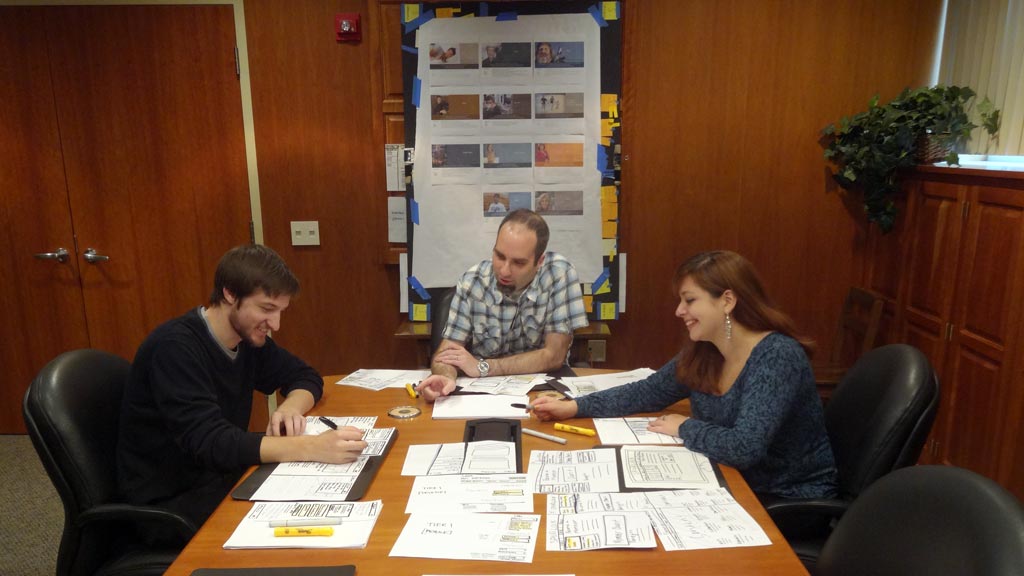
Interviewing Former IT Students: Andy Estabrook
- Post Date: 12/14/2020
- Author: Seetha Ramaswamy, IT student
- Reading Time: 6 minute read
From Fall 2013 until 2014, Andy Estabrook worked in the IT section of the Museum mainly on website development. He majored in Media Studies in the College of Media (external link) with an Informatics minor (external link).
Coming to Spurlock
Seetha: Why did you want to work at the Spurlock Museum?
Andy: By my junior year, I wanted to find a job that would gear me up towards my career. I wanted more hands-on computer experience and to do something in the IT field. I was, and still am, a big computer person. I found that working [in the IT section] at Spurlock was a practical application of the things in my interest set at the time.
Working at Spurlock
Seetha: What was the most memorable project that you worked on?
Andy: The website redesign was my overarching macro project, which I spent at least a year on. It was a multi-staged and multifaceted endeavor with the sketching, coding, and production occurred in the second half of 2014. The main parts I worked on for this project were the virtual tours on the website, the design for the various pages of the redesigned site, and the persona profiles for potential users. For the question of virtual tours, there was already a virtual tour option of the website but it was not mobile friendly. As part of the website redesign, I did research on whether or not we should keep it. In our goal of trying to make our website as accessible and applicable to its users as possible, persona profiles were one of the tools we used.
Seetha: What are persona profiles and why were they used in this project?
Andy: The persona profiles are basically mock profiles of various people we thought might visit our site. Keeping in mind who would be most likely to visit our site—college students, educators, general community members, donors—we needed to create a website that could address the needs of each of these profiles. The persona profiles allowed us to test different use cases, personalities, etc. to trial and error test navigation design of the website. This helped us determine what would stay on the website: if you can imagine what you think your target audience needs, you can design what they need based on “who” they are. For example, one of the personas I created was a middle schooler who has an iPad at home, which allowed me to consider how the website would need to be mobile friendly.
This was my most memorable and most challenging project and I had a ton of fun doing it. It gave me a lot of great experience in understanding UX design and gave me an eye for design that has carried into my current job.
After Spurlock
Seetha: What are you doing now?
Andy: I currently work at the media agency Spark (external link) located in downtown Chicago. I work in the media strategy team as the Associate Media Director. Basically, I don’t make any of the ads, but I determine where the ads and/or media should go and I am the key point of contact for clients. As I continue to work here at Spark, my level of involvement and contact with my clients increases. Recently, I started handling global market media strategy as well, which was interesting because it made me consider: how do you plan media strategies for a location you don’t even live in? But it has given me a nice world view and the opportunity to see media from not just a U.S. standpoint but also from a global viewpoint.
Seetha: What do you think are the benefits of a museum like Spurlock and/or the benefits at working at a museum like Spurlock?
Andy: I think that now more than ever, museums and any other educational facility are extremely important. Museums are grounded in a necessary truth about history that we all can learn from. I am a huge proponent of academic/educational facilities in any format. As the cliché goes, knowledge is power and I think that is truer now than ever before. I think that seeing patterns of instability in information dissemination with social media, such as mistruths and half truths, makes it even more crucial to have spaces dedicated to historical truth.
Seetha: Do you think working at Spurlock has helped you in any way with your career?
Andy: In hindsight, I can actually see some similarities between the persona profile work I did then and the work I’m doing now. At the core, it's about identifying your target audience and planning on how to appeal to them. When I first came into Spark, the persona profile work I did at the Museum was definitely a useful framework to have. There was a lot of aggregate consumer data I was presented with that could be used to build consumer profiles, which could then be compared to media usage in order to create media strategies for our clients. When we first talked about the persona assignment at the Museum, it was relatively new to me at the time. I have always liked analytics and research, so I think that was relevant with taking up the persona work I did back then and with further applying that interest at Spark.
My experience at Spurlock was great and it reconciled two angles for me: computers and technology (what I wanted to do at that stage in my life) and educational, awe inspiring knowledge (something I’ll always appreciate). I also enjoyed the team as much as I enjoyed the actual IT work: it was a great environment. It's been a job that has stuck with me, definitely.
-
- Share:
- Subscribe to Newletter
- Giving



